A textural journey/journal to share
Enjoy the view
“Happiness lies in the joy of achievement and the thrill of creative effort.”
Franklin D Ro0sevelt.

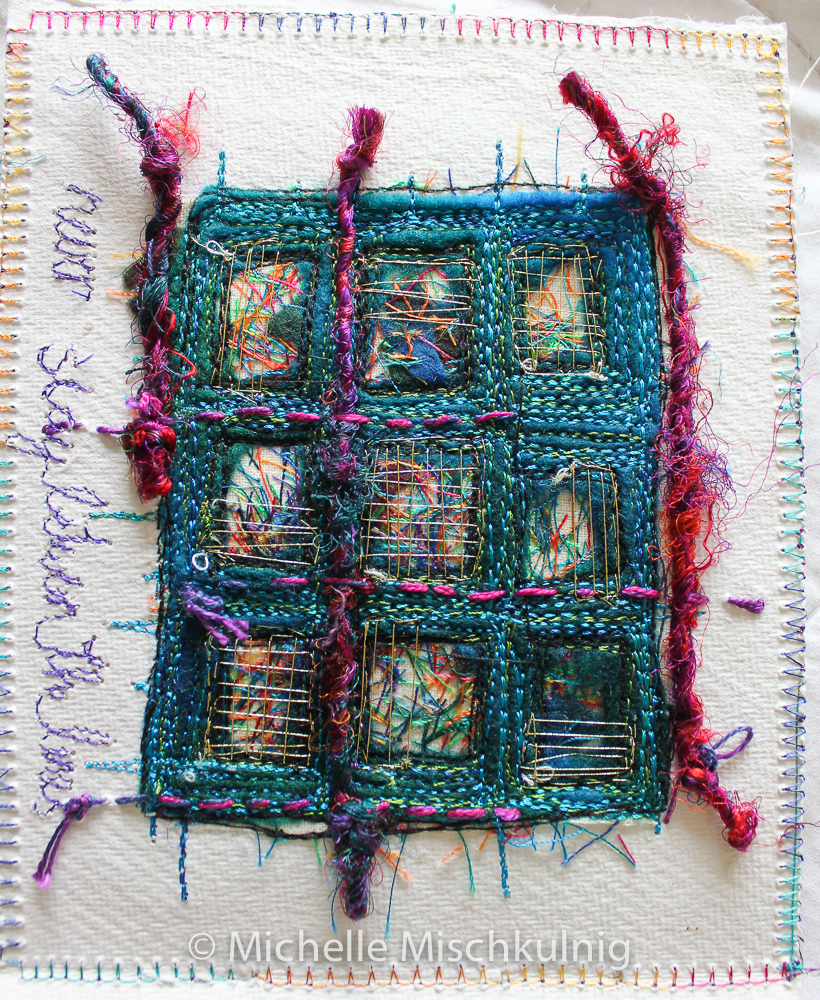
This week in my studio I have finished a sea horse textile art work , “Sassy Sea horse ” pictured at the end of the post. In completing this I was inspired to think of a little ongoing project we can share.The idea is that I share with you some interesting textures, I will do this over a number of posts, texture that surrounds us and embraces us with its tactile conversations. My textile art work is inspired by life and I observe in layers of texture and colour.
In my creative mind these little experimentations and play times will become a beautiful reference journal for you to own.My plan is that over the next couple of months I will share small texture projects with you and these can be slowly added to your journal or however you wish to keep them. When your journal pages are completed and we have created 8-10 different textures we will make a cover for the album and add any embellishment our hearts desire to own a special reference book for future projects.
I would love some feed back, please let me know if you are interested in a ongoing project of simple textural ideas ? As this takes many hours for me to prepare and post I need to know there is interest to continue.
Our first two pages of the journal
Page 1

Materials
1. Khadi cotton rag book I am using the 40 page block as that size suits me.I like to use cotton rag for its versatility and strength when stitched http://www.thethreadstudio.com/catalogue/exp/papers.htm
2. Felt or velvet or such fabric of your choice.
3.Melting fabrics.Most synthetics
4. Lace.or fabric of choice
5. Hand stitch thread.
6. Deli paper http://www.thethreadstudio.com/catalogue/exp/papers.htm
7. Metallic fabric
8.Heat gun and its instructions :-)
9. Gold rub or similair
10. Free motion foot
11. Sewing machine
12. Machine embroidery threads
13. Fusible web
14. baking paper
15.Top stitch 80 machine needles
Page 1
As I wont be filling my Khadi paper rag book with samples I will remove the pages as I use them but as double pages.
If you wish remove the first page for experimneting ( if you choose you can adapt and fill the book with lots of lovely experimenting)
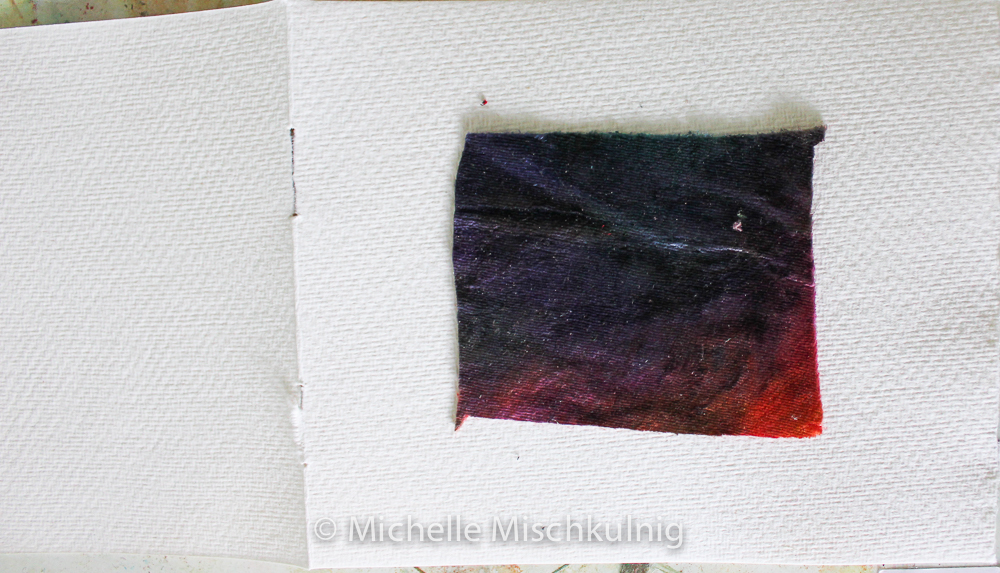
Fuse a layer of felt or such to the Khadi cotton rag as the first layer of the melting fabrics ( I have used velvet as I dont want the bottom layer to melt), most synthetics melt easily when a heat gun is applied. To fuse it I use a peeled layer of fusible web cut to the same size as the felt.It is fused with a hot iron and baking paper to protect the surface.
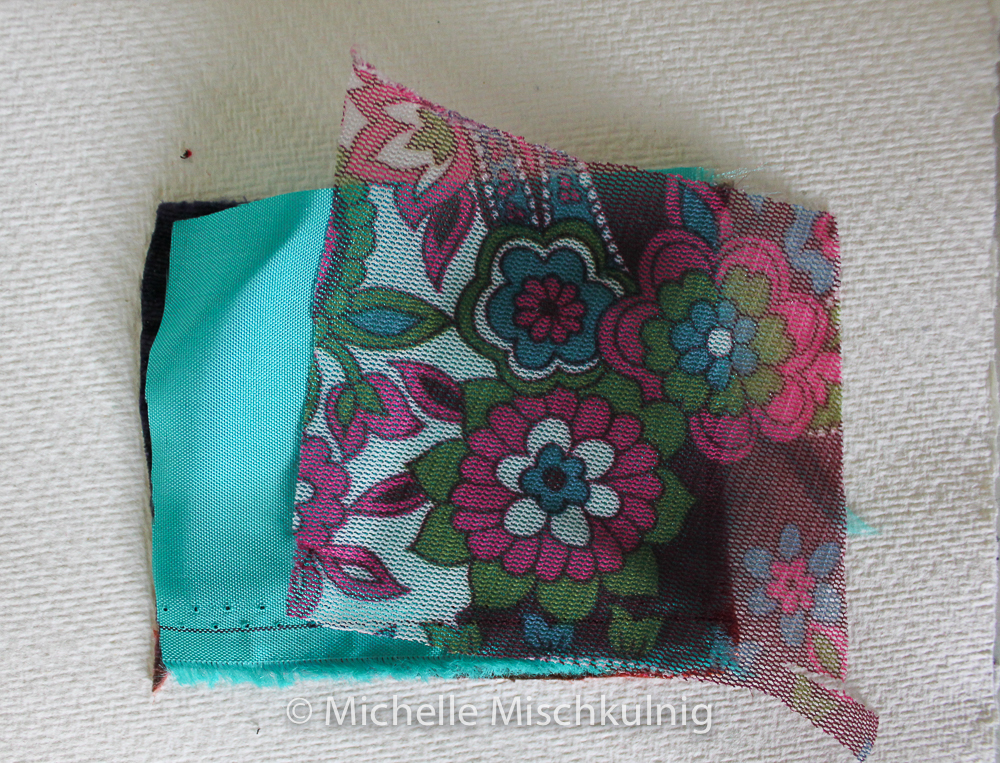
Follow through with another 2-3 different melting fabrics these can be fused together with peeled fusible web in between each layer and baking paper to protect both the iron and the fabric.
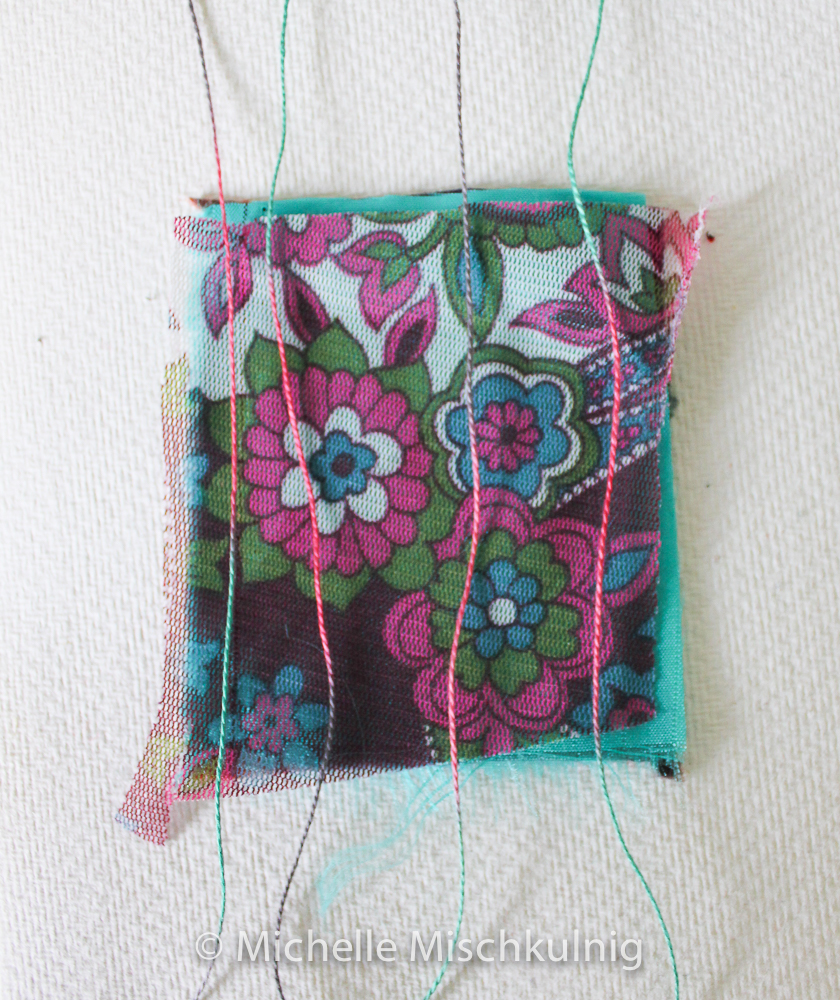
Lay some cotton or wool hand embroidery thread across the surface these wont melt.Metallic fabric when melted will also add depth and interest.
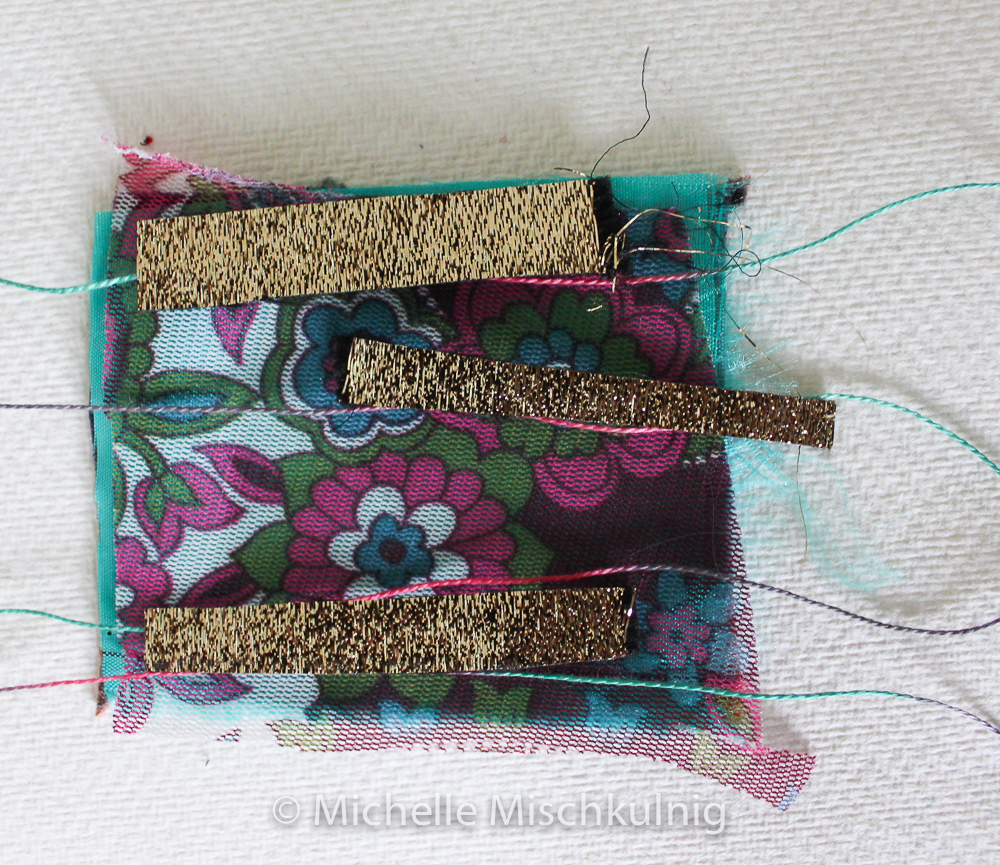
Complete your melting layer with some lace or any fabric similar.

Fuse all the layers together by layering with fusible web and covering the top layer with baking paper and then melting with a hot iron.
After it is fused use the free motion foot to embroider and when it is all stitched to your liking use a heat gun to melt the fabric. Take care using the heat gun and use in open air the fumes can be quite strong. How much you melt it back is your choice.

Once melted I rub some gold finish over the lace which picks up the relief texture of lace.
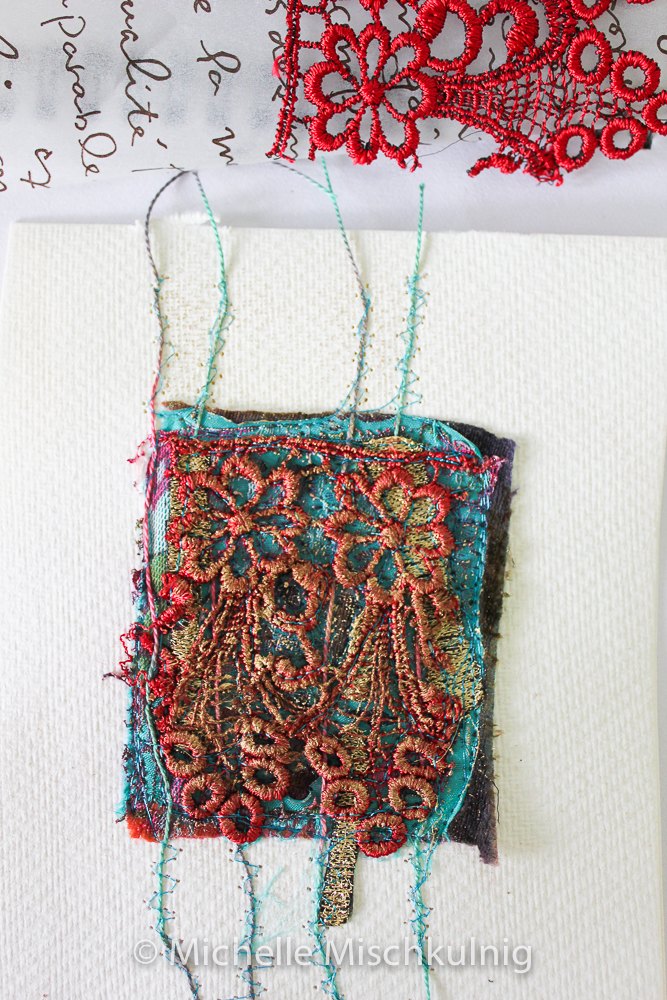
I am going to surround the melted fabrics with a frame cut from a piece of deli paper which will then be fused onto the cotton rag.To do this I lay the fusible web over the whole rag paper size and mark the size of the window to be cut. This is done by drawing on the fusible web around the out side edge of the melted fabric once the the fusible web is marked and cut use it for a template for the deli paper.
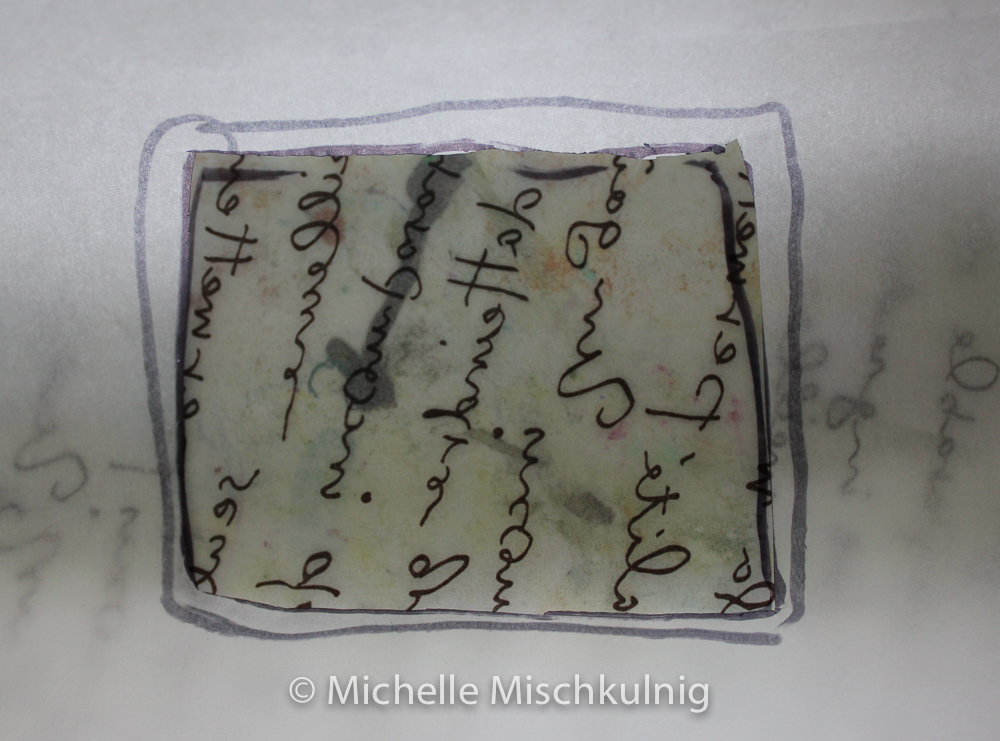
Peel the fusible web off the backing and lay over the melted fabric, the cut frame should fit around the outside edge of the melted fabric, repeat with the deli paper.Cover both layers with baking paper for protection and use a hot iron until fused flat to the rag cotton paper.

A little hand stitching to enhance and add another dimension and some patterned machine stitching.
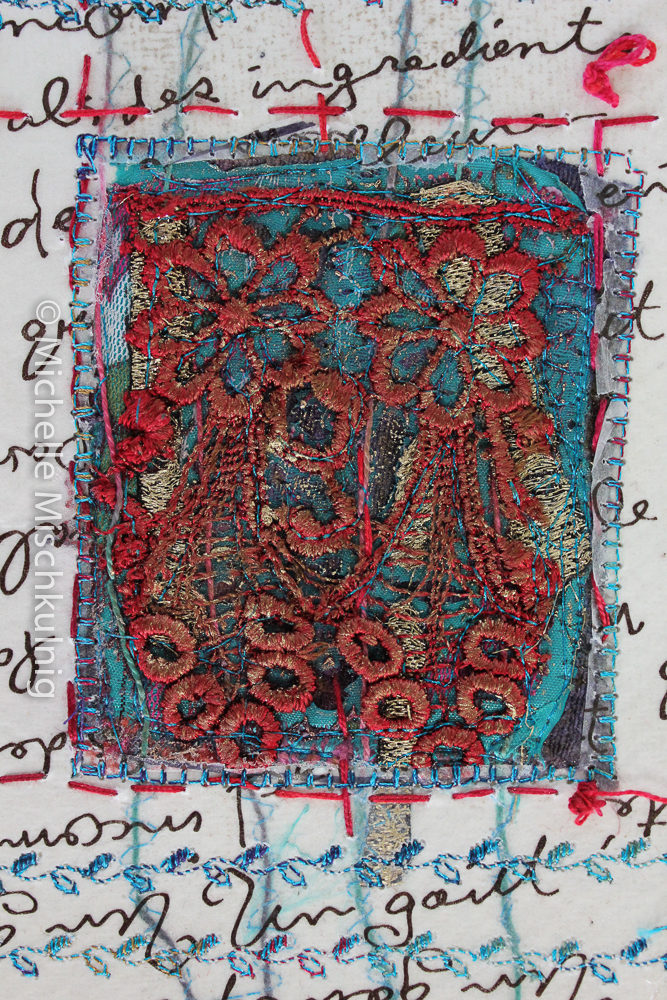
As final layer I have added small velvet circles and green stems
In this image you can see the texture and depth and know there is so much more you can develop with this technique.A way to make it your own.
Page 2
Materials
- Felt
- Yarn
- Hand stitch thread
- Metallic machine thread
- Sewing machine
- Free motion foot
- Khadi paper.
- Machine embroidery threads
- Sewing machine
- Hand needles
- Top stitch 80 machine needles
- Calico
- Felt, velvet or such
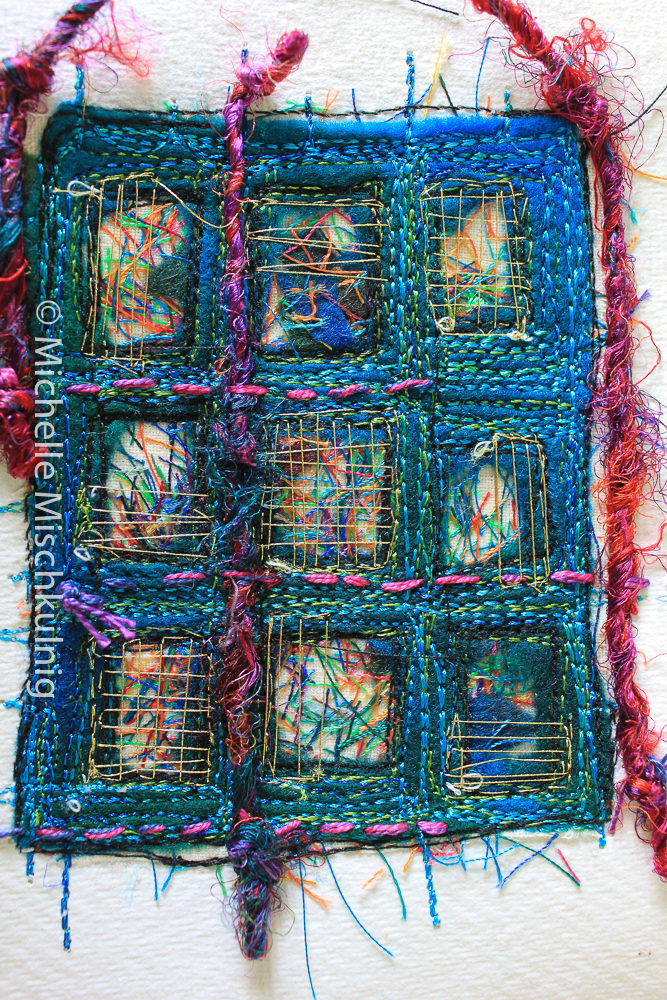
Take another double page from your Khadi rag book, a fresh to page to start working page 2 on.
To start with cut a piece of calico or your choice of fabric that is approx. the size of the melting fabric on page one. Attach the calico with a layer of peeled fusible web which is sandwiched between the calico and rag paper, fuse with hot iron and baking paper protecting the materials.
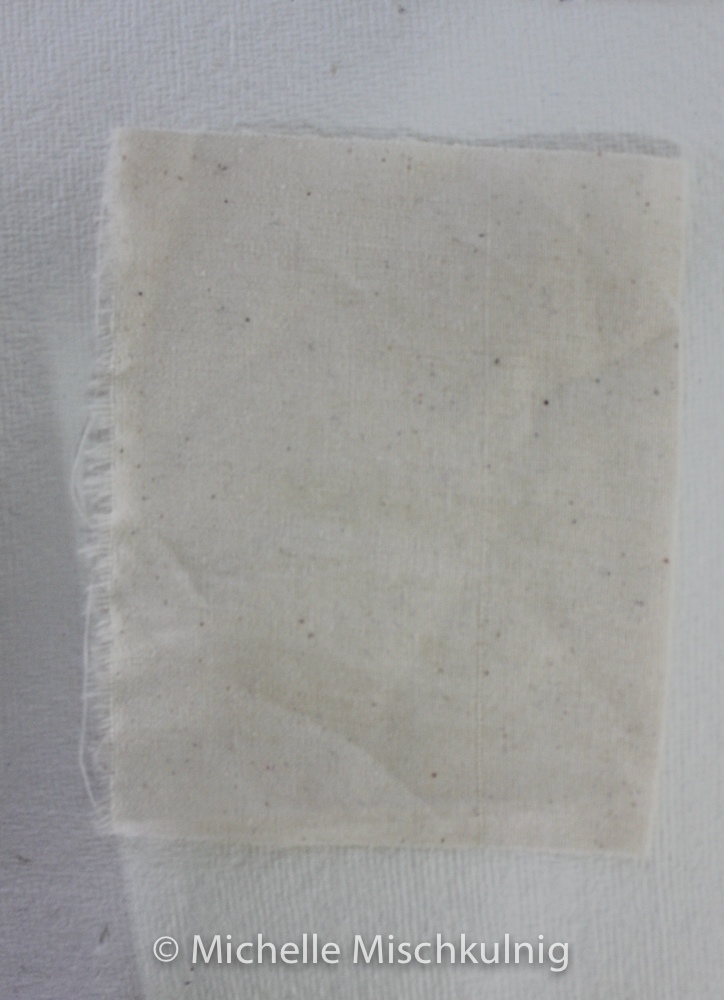
Place another piece of peeled fusible web the same size as calico onto the surface of the calico and make snippy sprinkles from a collection of threads etc. Fuse this to the calico again using baking paper and hot iron
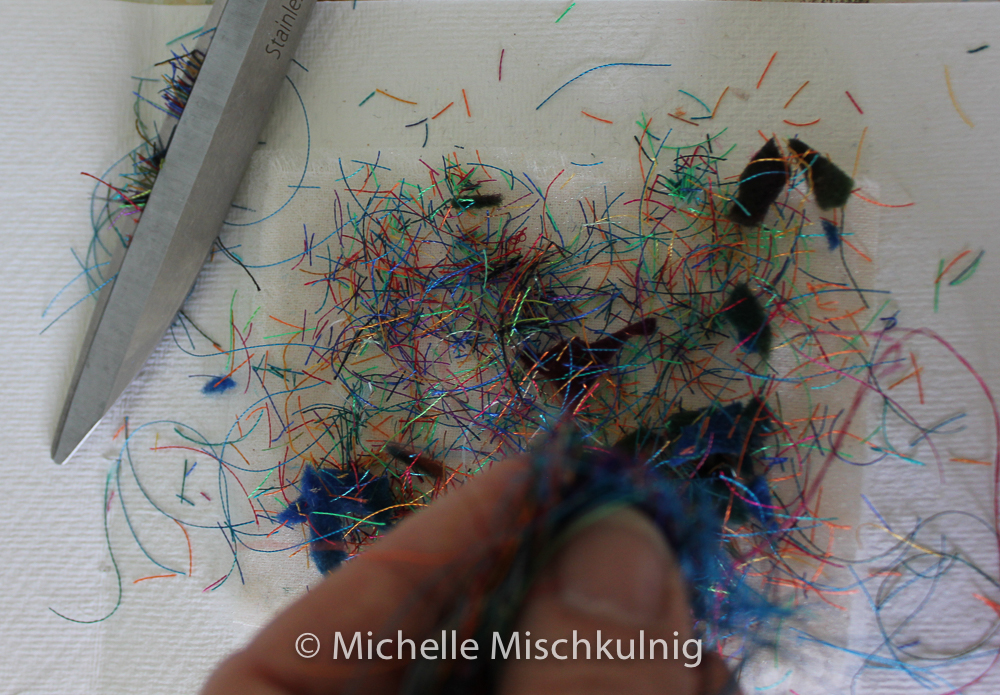
Next I cut square/holes out of some hand dyed felt.You can use whatever fabric you wish each will give a different texture, sheer could be rather wonderful as could silk or velvet.
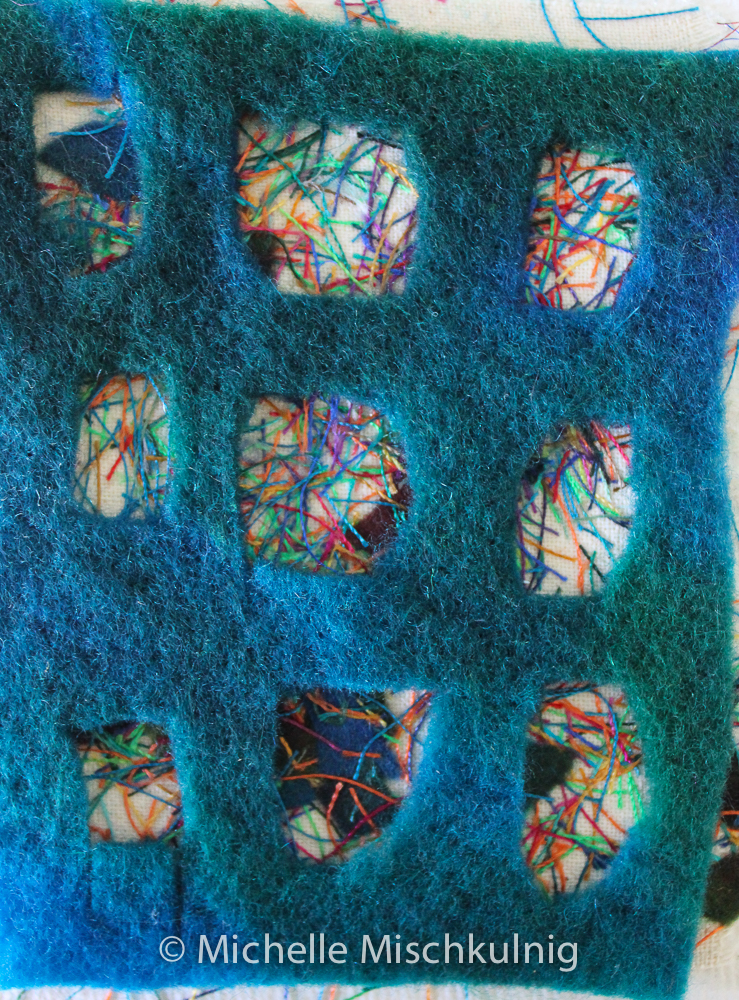
Stitching the felt to the surface of the rag aper creating little windows for the sprinkles to sparkle through.
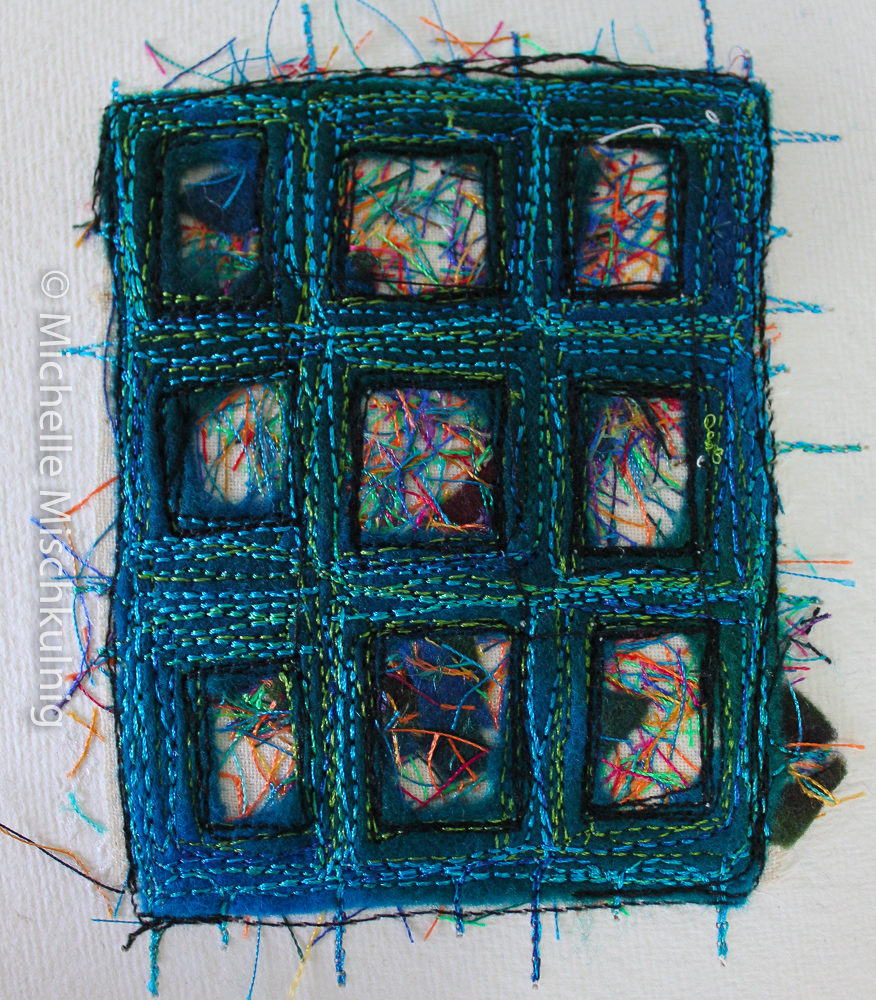
I always believe a little hand stitching adds a depth try attaching some silk yarns with hand stitches.

To finish this textural piece I am filling the squares holes in with a long stitch. Not all sewing machines will allow you to do this, it is worth the experiment. Hold your machine foot on one edged and do a few free motion stitches in the one position and then stretch thread across to the other side of the window, by lifting the foot and carrying the thread across.
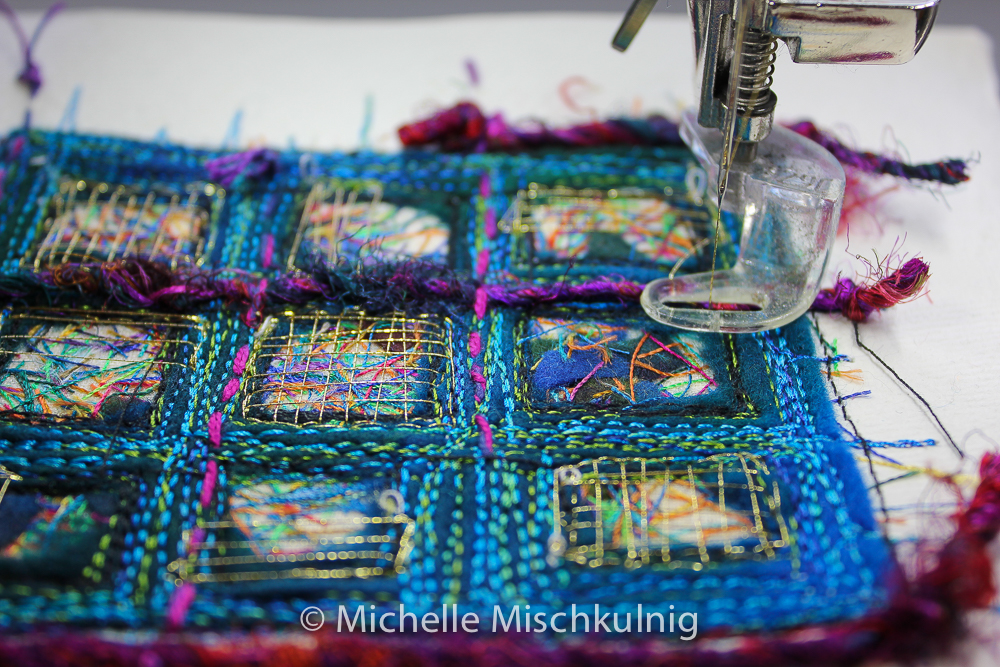
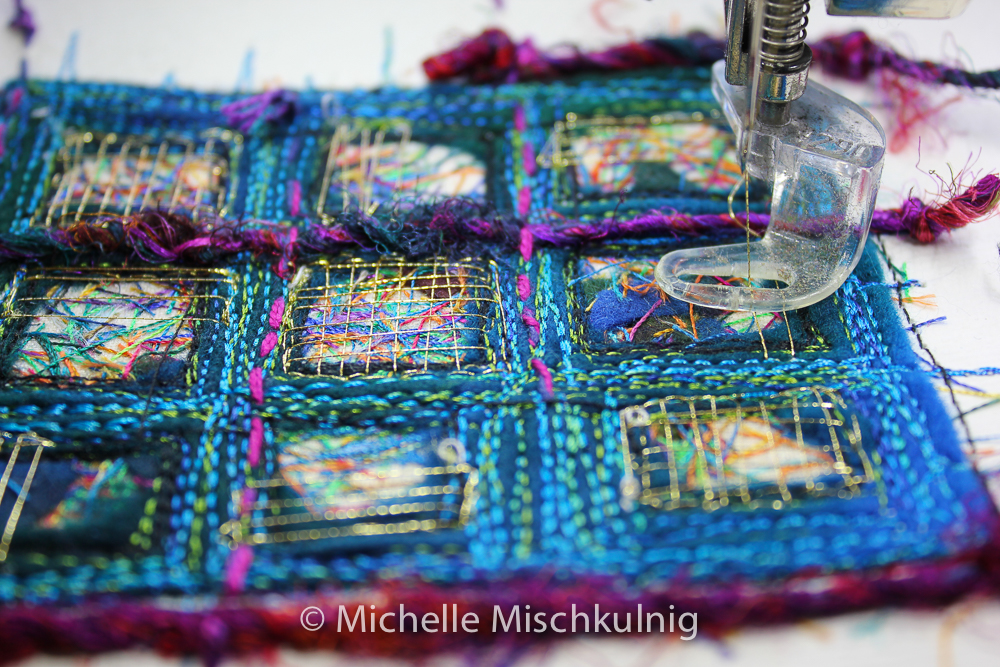
The final step with these textural experiments is to secure the pages together.I use double sided tape and then a machine pattern stitch to fix them together .So one page is the front the other attached to back, leaving two blank pages to be used next time .
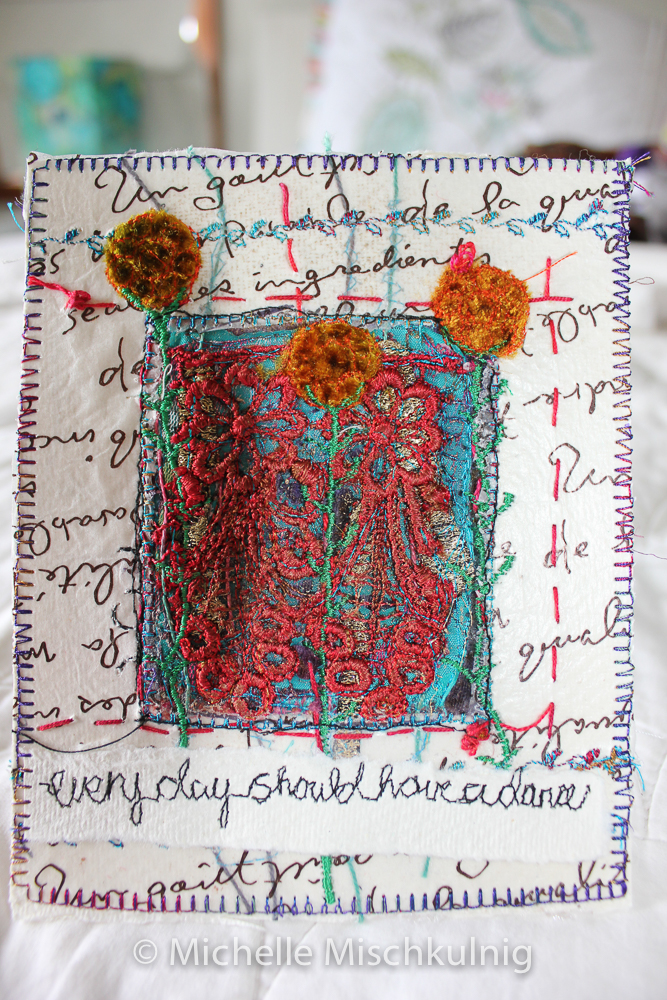

The Sassy Seahorse
This week in my studio I finished the seahorse art work below, have a close look at all the texture and think about how and what you can use to create depth and movement.
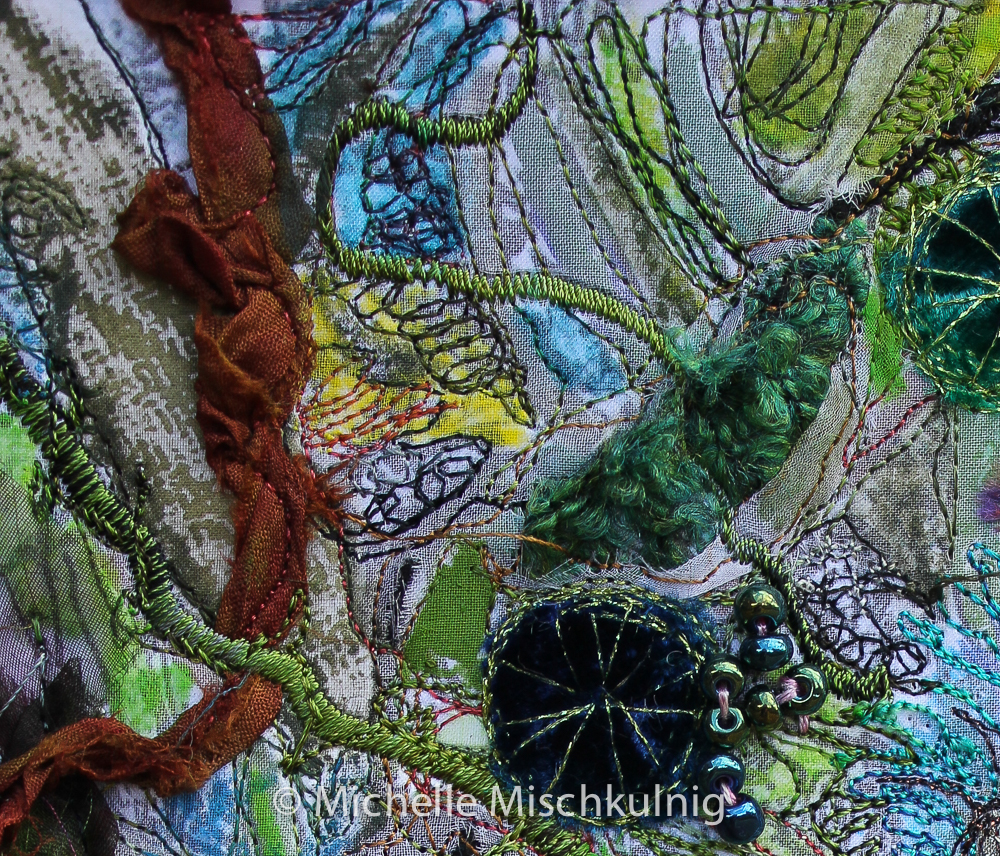
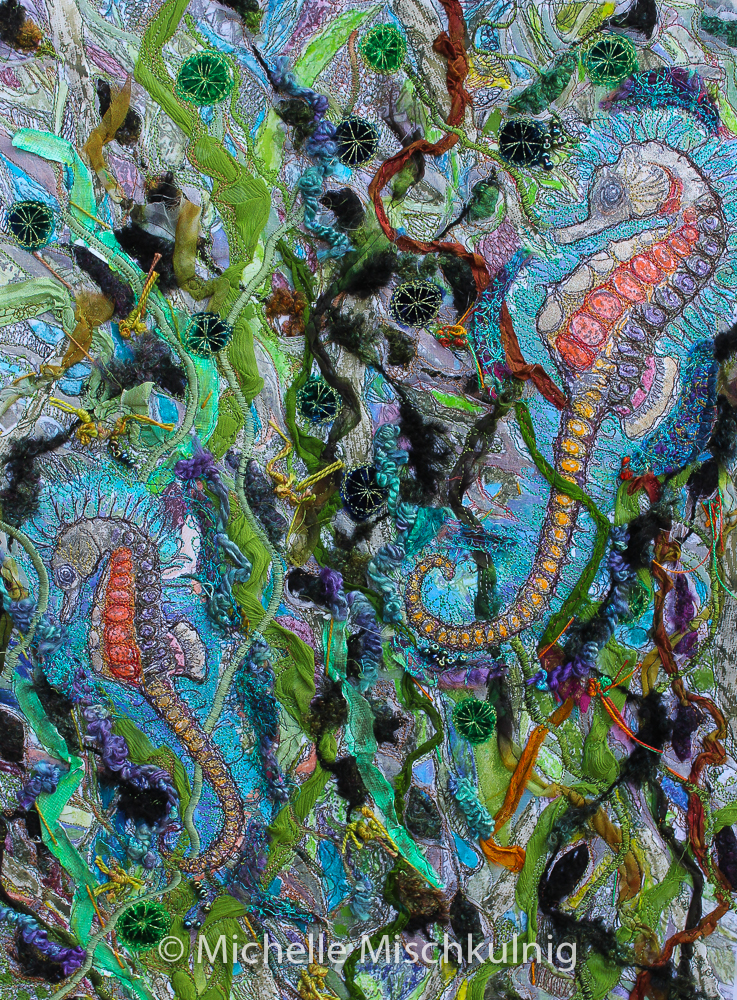
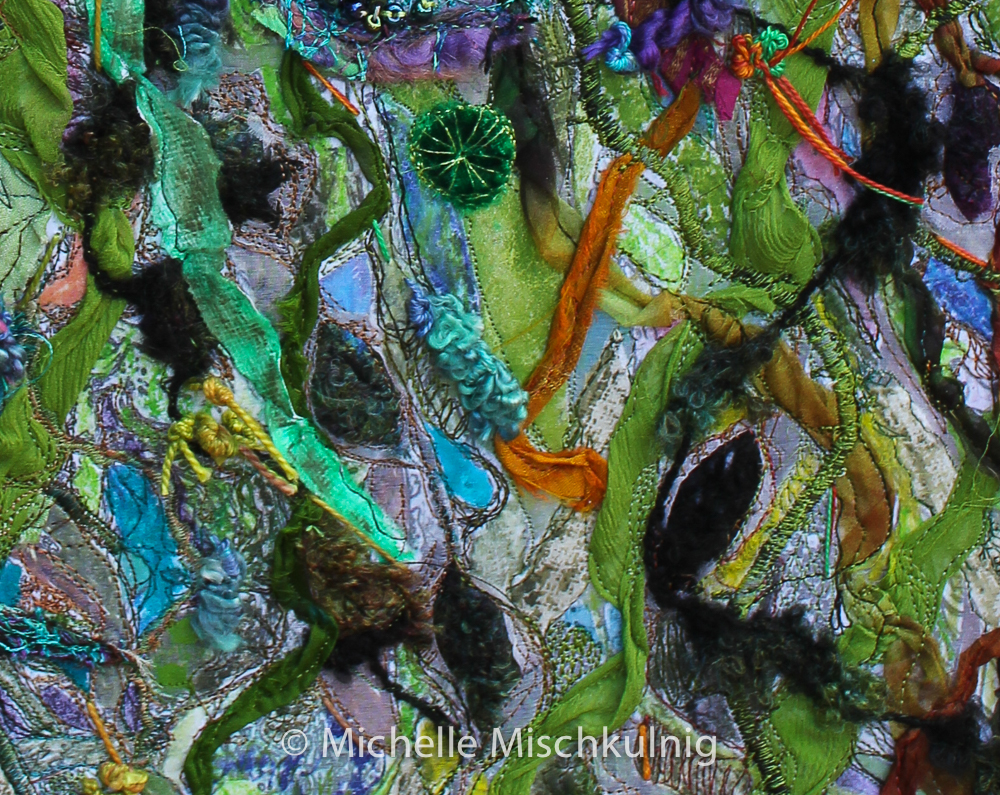
I am teaching at “Threads and Tangles” where we will building up a textural background with hand dyed silk caps and hand painting our 3D butterflies. When finished this will be a framable art artpiece . There are only a few places left in the class and it is possibly the last time I teach in Melbourne until 2018.Come and join me for some fun and free motion embroidery.


Thanks Joanne I hope to have another blog out at the end of this week.
I would love to experiment with texture following your blog. Thank you
Hi Michelle thanks for your message I hope I can inspire you to continue creating and that some of my ideas are of interest to you.
Such wonderful insight to your work. I am sure there is so much to learn from your processes, thankyou for the opportunity ☺
oh dear Gjeneve thats not too good but at least if you are in rehab you are on the road to full recovery. By the time you get started on this project you will be able to whip through lots of play not have to wait in-between for me to post.best wishes for a speedy recovery. I am teaching in the States next year at Lake Tahoe Art Quilt Retreat can wait.
I am definitely interested in following and doing your texture challenge. Right now I am in rehab for a broken hip about 18 hours from my home, but will catch up and work when I am able to go back to Colorado, USA.
Thats great Karen I will be pleased to share with you
I would love to follow along with your journal. Excellent idea!
Hi Marilyn I am quite sure you will enjoy the journey and take it all in with gusto :-)
Fabulous Penny look forward to sharing.
I would love to follow along on this. It would be so much fun to see what I could learn while doing this.
Loved this.
Would love to have a go and would enjoy following your posts
Thank you Jenny I hope it inspires you to create your own textures.
This is a wonderful idea; thank you so much for your generosity.
Hi Elise so pleased to hear from you and that you will be busy creating this weekend.:-)
I love to hear your passion Debbie and am so leased you will be trying these techniques.
Hi Norma great to hear from you and I ma so glad for the positive response I have recieved.
These are fabulous. I will be making the first two this weekend. Yes please to having more. What a lovely idea! Thank you for all the work you put in.
I would love to see the process for making these creative pages, thank you very much.
Your use of unusual items and also ordinary items makes for the great art that I see on your site, you were featured in a quilting magazine, and I love your style. Glad I found you!
Thank you for your inspiration Michelle & hope to try this and more of your ideas if you are able to share them. I love your work.
Norma
Lucky you on holidays.I look forward to mine in January.Thanks for your ongoing support Yvonne.
Gracias Ceci I will keep posting new ideas.
Love a girl up for a challenge you will whiz through these two examples, but it is also about making them yours, seeing where you can take these ideas and knowing there are no boundries.
Yes Helen there are endless possibilities I hope you have great success.
I love enthusiasm and I hope my ideas inspire you to continue to create.
Hi Amy thank you for your lovely reply it is heart felt.
Thats great Irene that give me confidence to continue.
Thanks Jean the response has been great I will continue :-)
Thank you so much for sharing this , it is a project I look forward to doing. At the the moment I am away from home on holiday but come September I will be up and running. I do hope you get lots of yes please replies!
Gracias por compartir !admiro suß tapices,
Very timely, I was up for a challenge! Thank you so much for sharing, great examples to start us off.
Lovely. I’m going to try that sewing across the hole with long stitches. Keep them coming.
Yes please, love to watch and learn!
Your work is exquisite…the color, texture, attention to detail…so impressive and inspiring…
Love these ideas, would be very pleased to see more ideas! Thank you.
I have always admired your work and this would make me do it
Thanks Dee if i get a good response I am happy too. So fingers crossed.
I love it when your posts come up! The texture pages are a really good idea. Your explanations and pictures are so clear. It would be very generous of you to share like this so I hope you do!